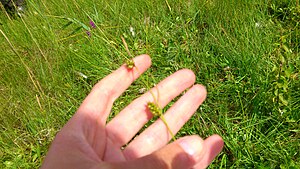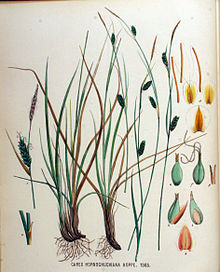Hem sedge
| Hem sedge | ||||||||||||
|---|---|---|---|---|---|---|---|---|---|---|---|---|

Hem sedge ( Carex hostiana ) |
||||||||||||
| Systematics | ||||||||||||
|
||||||||||||
| Scientific name | ||||||||||||
| Carex hostiana | ||||||||||||
| DC. |
The fringing sedge ( Carex hostiana ) is a species of the genus Seggen ( Carex ) within the sour grass family (Cyperaceae).
description
The border sedge is a gray-green, perennial herbaceous plant and reaches heights of 25 to 45, rarely up to 80 centimeters. It forms short runners and therefore has a loose-grassed to clumpy habit. The stems are triangular, stiffly upright and longer than the leaves. The leaves are 2 to 4 millimeters wide, keeled and rough. Your bulbous leaf sheath wall has a 1 to 2 millimeter long, dry-skinned appendage. The basal leaf sheaths are light green to reddish brown and frayed.
The flowering time is in May and June. The hem sedge is a variegated sedge. There are one male and two to three female spikelets . The female spikelets are short stalked, 1 inch long and erect. The bracts have long sheaths and enclose the spikelet stalks. The lower bract is at least as long as its spikelet, but shorter than the entire inflorescence .
The bracts are ovate, blunt to pointed, but without a spike tip. They are red to dark brown and have a green central stripe. They have a narrow, white skin edge and are shorter than the fruit. The stylus has three scars .
The yellow-green, bald fruit is 3 to 5 millimeters long, spherical to egg-shaped and changes abruptly into the deep beak. The beak is smooth on the inside and has a narrow skin edge, on the outside it is rough.
The number of chromosomes is 2n = 56.
Occurrence
The hem sedge is common in Europe and eastern North America . It is a submeridional-montane to boreal, oceanic flora element . In Central Europe it is widespread in the Alps and in the Alpine foothills , otherwise scattered. It generally rises to altitudes of 1500 meters. In the Allgäu Alps it still occurs on the Besler in Bavaria at an altitude of 1670 meters.
It grows in mesotrophic , wet flat moor meadows . In Central Europe it is a character species of the Caricion davallianae association, but also occurs in companies of the Molinion association.
Taxonomy
Carex hostiana was first published in 1813 by Augustin Pyrame de Candolle . The specific epithet hostiana honors the Austrian doctor and botanist Nicolaus Thomas Host (1761–1834).
literature
- Rudolf Schubert , Klaus Werner, Hermann Meusel (eds.): Excursion flora for the areas of the GDR and the FRG . Founded by Werner Rothmaler. 13th edition. tape 2 : vascular plants . People and knowledge, Berlin 1987, ISBN 3-06-012539-2 (area).
- Siegmund Seybold (Ed.): Schmeil-Fitschen interactive . CD-ROM, version 1.1. Quelle & Meyer, Wiebelsheim 2002, ISBN 3-494-01327-6 .
Individual evidence
- ↑ a b Erich Oberdorfer : Plant-sociological excursion flora for Germany and neighboring areas . With the collaboration of Angelika Schwabe and Theo Müller. 8th, heavily revised and expanded edition. Eugen Ulmer, Stuttgart (Hohenheim) 2001, ISBN 3-8001-3131-5 , pp. 190 .
- ↑ Erhard Dörr, Wolfgang Lippert : Flora of the Allgäu and its surroundings. Volume 1, IHW, Eching 2001, ISBN 3-930167-50-6 , p. 276.
Web links
- Carex hostiana DC., Hem sedge. In: FloraWeb.de.
- Hem sedge . In: BiolFlor, the database of biological-ecological characteristics of the flora of Germany.
- Profile and distribution map for Bavaria . In: Botanical Information Hub of Bavaria .
- Carex hostiana In: Info Flora , the national data and information center for Swiss flora .
- Distribution in the northern hemisphere from: Eric Hultén, Magnus Fries: Atlas of North European vascular plants. 1986, ISBN 3-87429-263-0 at Den virtuella floran. (swed.)
- Thomas Meyer: Data sheet with identification key and photos at Flora-de: Flora von Deutschland (old name of the website: Flowers in Swabia )
- Data sheet with photos.
- Wanted poster with photos.
